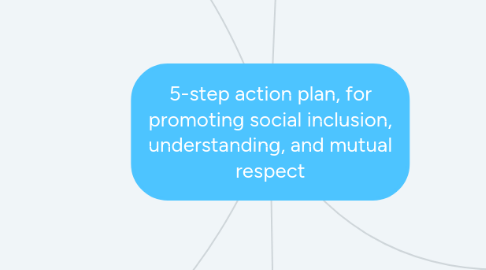
1. 1. Bridging Cultures/ celebrate diversity
1.1. Who?
1.1.1. Teacher would lead discussions/exercises which involve all students.
1.2. What?
1.2.1. Discuss/study/present on important cultural points and celebrations relative to not only the student population but to society as a whole.
1.3. Where?
1.3.1. Primarily classroom based
1.4. When?
1.4.1. Ongoing, many of the topics can be woven in to the curriculum year round. Learning about and celebrating relevant events throughout the year. For Example, Christmas and Hanukkah in December and Eid in June.
1.5. How?
1.5.1. Classroom projects,
1.5.2. Video presentations
1.5.3. Sharing foods/traditions
2. 5. Product - Allow students to share their knowledge
2.1. Who?
2.1.1. Student lead
2.2. What?
2.2.1. Allow students to show their learning via any media
2.2.1.1. Show and tell
2.2.1.2. presentation
2.2.1.3. video
2.2.1.4. written report
2.2.1.5. Story book/creative writing
2.3. Where?
2.3.1. Classroom
2.3.2. homework
2.3.3. drama class
2.4. When?
2.4.1. End of topic
2.4.2. Mid term
2.4.3. Post-school break
2.5. How?
2.5.1. Integrate with other teachers' i.e drama, dance, ICT etc...
2.5.2. Allow for students' creatvity
2.5.3. Allow student's to make their learning relevant to them, share their own experiences
3. 2.Bridging Social Barriers
3.1. Who?
3.1.1. lead by the teacher
3.2. What?
3.2.1. Assigning pair or group work in order to facilitate interaction between students
3.3. Where?
3.3.1. In class or field work
3.4. When?
3.4.1. Throughout the school year but in particular during classes such as reading or science where peer-to-peer learning is most effective. This also helps ELL learners as it facilitates small group discussions which may increase comfort levels of the learner.
3.5. How?
3.5.1. Modify work-load to include more group/pair work.
3.5.2. Assign some of the students who are less challenged to help others.
3.5.3. Rotate pairs
4. 3.Bridging Communication barriers
4.1. Who?
4.1.1. Lead mostly by the teacher, however during group work guidance given to others in the group
4.2. What?
4.2.1. Use visual aids
4.2.2. captions on videos
4.2.3. always face the learner when speaking
4.2.4. use simplified english
4.2.5. repeat instruction
4.2.6. Speak at a comfortable pace
4.3. Where?
4.3.1. In classroom however, audio and video can be easy incorporated into homework as could online work.
4.4. When?
4.4.1. Throughout the curriculum although methods can be adapted as the student's proficiency increases
4.5. How?
4.5.1. Visual aids posted around classroom for student to refer to when needed
4.5.2. individual instruction if needed
4.5.3. Captioning videos when showing the class as a group / perhaps even translation subtitles
5. 4. Assesment
5.1. Who?
5.1.1. Teacher and school administration
5.2. What?
5.2.1. Modify work to address needs of ELL.
5.2.2. Allow extra time
5.2.3. Allow use of other resources, dictionary/translator
5.3. Where?
5.3.1. Classroom
5.3.2. Online assesments
5.3.3. Private settings to avoid esteem issues especially when assessing speaking skills
5.4. When?
5.4.1. Regularly throughout school year to ensure that material covered is being comprehended.
5.4.1.1. Encourages early intervention should the learner be struggling with any part of the workload
5.5. How?
5.5.1. Small end of topic quizes
5.5.2. Regular one-on-one speaking/reading assessment
5.5.3. Use of online reading comprehension tools

